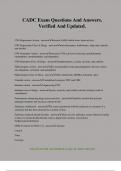EXAM STUDY MATERIALS July 25, 2024 1:06 PM CADC Exam Questions And Answers. Verified And Updated. CNS Depressants Action - answer✔✔Increase GABA which slows brain activ ity CNS Depressants Class of Drugs - answer✔✔benzodiazepines, barbiturates, sleep aids, opioids, and alcohol CNS Stimulants Action - answer✔✔Increasee CNS activity by releasing catecholamines (epinephrine, norepinephrine, and dopamine) CNS Stimulants Class of Drugs - answer✔✔amphetamines, cocaine, nicotine, and caffeine Hallucinogens Action - answer✔✔affect acetylcholine in the parasympathetic nervous system, also dopamine, serotonin, and epinephrine Hallucinogens Class of Drug - answer✔✔LSD, mushrooms, MDM A, ketamine, spice Cannabis action - answer✔✔Cannabinoid receptors THC and CBD Inhalants action - answer✔✔suppressing CNS Inhalants class of drugs - answer✔✔gases, aerosols, and volatile solvents (nitrates work as vasodilators) Performance -enhancing drugs action and class - answer✔✔anabolic steroids that activate androgen receptors and increase calcium levels Substance withdrawal - answer✔✔The state experienced with the reduction or cessation of a substance that has been misused for a period of time Substan ce-induced mental disorder - answer✔✔when use of a substance creates behavior similar to that of a mental health disorder such as depression, anxiety, or psychosis (hallucinations/delirium) DSM -5 Criteria for SUD (11) - answer✔✔Amount Control Time Cravings EXAM STUDY MATERIALS July 25, 2024 1:06 PM Obligations Social Importance Risk Harm Tolerance Withdrawal The 5 Stages of SUD - answer✔✔1. Abstinence 2. Experimental Use 3. Social Use (Mild SUD) 4. Abuse (Moderate SUD) 5. Chemical Dependency/Addiction (Severe SUD) Psychological dependence - answer✔✔Cravings, urges, and the desire for substance use Physical dependence - answer✔✔the result of brain changes due to drug use, where the brain starts to require the heightened state of activity produced by the drug and ther efore creates physical reactions when the drug is absent Dependency - answer✔✔a brain disease characterized by an uncontrollable desire to consume increased quantities of a psychoactive substance Tolerance - answer✔✔requiring an increased amount of the sub stance to attain the desired effect Behavioral tolerance - answer✔✔when individuals display behaviors that mask the effects of substance use from others, including changes in disposition, attitude, or speech associated with psychoactive substance intoxicat ion Dispositional or metabolic tolerance - answer✔✔when a person's body tries to accelerate metabolism to rid itself of chemically toxic substances creating the need for more and more of the substance to be consumed Cross -tolerance - answer✔✔when people be come tolerant of psychoactive substances in the same pharmaceutical family as those previously tolerated (heroin to other opioids) Pharmacodynamic tolerance or cellular -adaptive tolerance - answer✔✔when neurotransmitters are altered so that the brain has b ecome desensitized to the substance which lessens the effects EXAM STUDY MATERIALS July 25, 2024 1:06 PM Reverse tolerance - answer✔✔when a person becomes more sensitive to the substance because the substance has harmed neuronal activity (alcohol and liver damage) Select tolerance - answer✔✔when so me effects of a drug are experienced and others are not (euphoric feeling gone but affects other parts of the body) 4 Stages of Withdrawal - answer✔✔1. Stage 1 within hours, varies by substance 2. Stage 2 intensification of symptoms (body aches, sleep dist urbances, depression, tremors, and anxiety) 3. Stage 3 Post -Acute sharp peak and then a decline in symptoms can last weeks or months and may need a medical professional (insomnia, emotional lability, memory impairment, and anxiety) 4. Post -Acute Withdrawal can last months to years and affects biopsychosocial functioning (memory impairment, difficulty thinking clearly, mood swings, cravings, anhedonia, suicidal ideation, fatigue, muscle aches, social withdrawal, and pain sensitivity) Anhedonia - answer✔✔inability to experience pleasure Medical detox is required when... - answer✔✔detoxing from alcohol and benzodiazepines 3 steps of detox management - answer✔✔1. Screening, assessment, evaluation 2. stabilization 3. treatment engagement What passes through the b lood-brain barrier easily? - answer✔✔fat-soluble substances (alcohol, cocaine) Half-life - answer✔✔duration of time it takes for half of the substance to be eliminated from the body Metabolism - answer✔✔process through which a substance is eliminated from the body Peripheral nervous system - answer✔✔somatic and autonomic nervous system The primary neurotransmitter of the parasympathetic nervous system is - answer✔✔acetylcholine (inhibiting) The primary neurotransmitter of the sympathetic nervous system - answer✔✔norepinephrine (excitatory) Amygdala - answer✔✔emotion, motivation, and memory formation in relation to the stress and fear response, most relevant in the withdrawal experience Reticu lar activating system - answer✔✔responsible for an individual's state of arousal EXAM STUDY MATERIALS July 25, 2024 1:06 PM Basal ganglia - answer✔✔motivation, movement -related functions, and habit formation (pleasure/reward pathways) Cerebellum - answer✔✔coordination, posture, motor skills, and mo vement Prefrontal cortex - answer✔✔thinking, planning, problem solving (especially relevant in adolescents) Hypothalamus - answer✔✔hormone production and sends hormones via pituitary gland (regulates the body's stress response) Neurons - answer✔✔specialize d cell that sends and receives biochemical information made up of the dendrites, axon, and soma Synapses - answer✔✔deliver neurotransmitters such as dopamine and serotonin from neuron to neuron Dendrites - answer✔✔receive synaptic inputs from axons Axon - answer✔✔part of the brain cell that determines whether or not a neuron will be fired to signal the release of a neurotransmitter Soma - answer✔✔cell body of the neuron that contains the nucleus, sends proteins through the axon/dendrites Acetylcholine (resp onsibility & drug action) - answer✔✔NT that is responsible for memory, attention, and mood affected by nicotine, caffeine, and hallucinogens Dopamine (responsibility & drug action) - answer✔✔responsible for the functions of movement, memory, concentration , and pleasure affected by cocaine, methamphetamine, alcohol, and opioids Serotonin (responsibility & drug action) - answer✔✔responsible for sleep, sexual desire, emotions, and digestion affected by MDMA, hallucinogens, and cocaine Endogenous opioids (en dorphins & enkephalines) responsibility & drug action - answer✔✔responsible for pain, mood, responses to stress, and sedation




